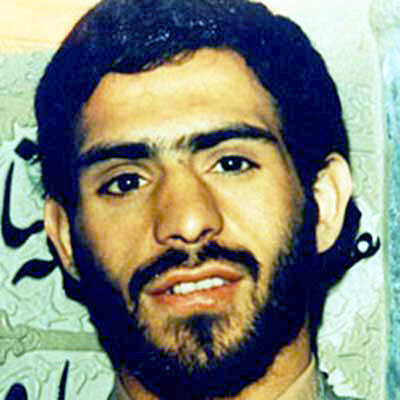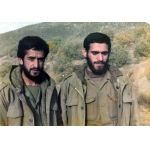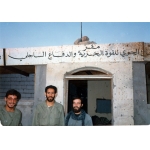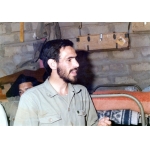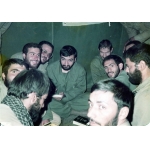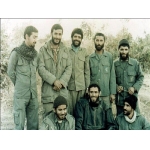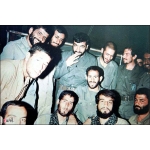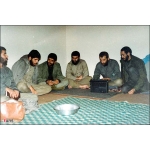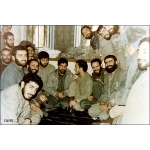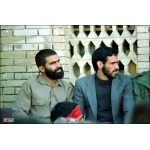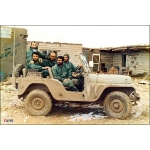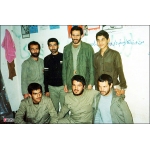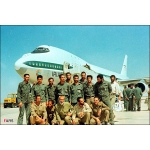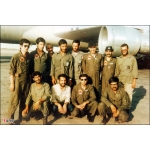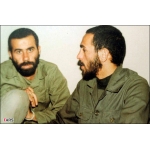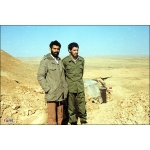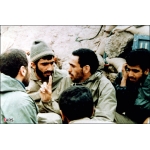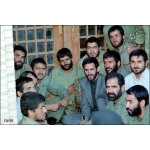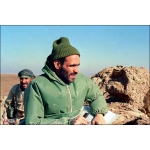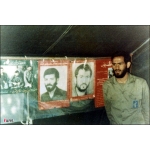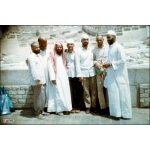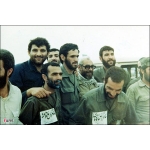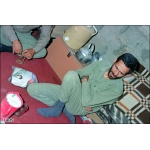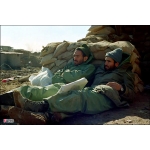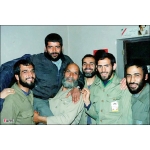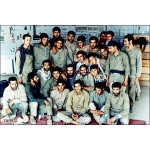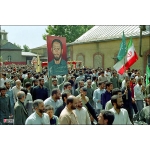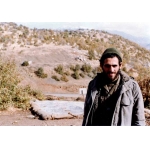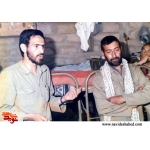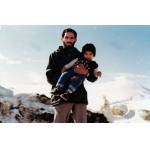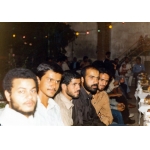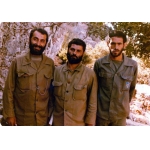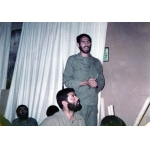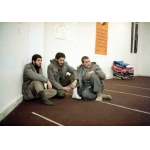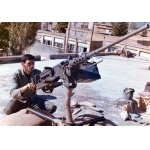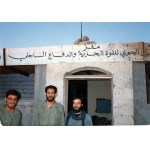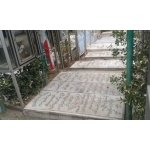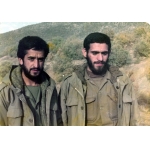Dastvareh, Seyyed Muhammad Reza
Shahrzad Muhammadi
229 بازدید
Sayyed Muhammad Reza Dastvareh was the deputy commander of the 27th Muhammad Rasulullah (pbuh) Division of the Islamic Revolutionary Guard Corps (IRGC). He was martyred on July 4, 1986, in Mehran. He was born on March 9, 1960, in the Goud-Moradi neighborhood of Tehran, near Shoush Square. His father worked at a salt factory.
In 1973, due to financial difficulties, he left school after completing high school and began working in a tailoring workshop in Tehran’s bazaar. However, a year later, driven by his passion for education, he returned to school and attended Pahlavi High School (now Shaheed Abed High School).[1]
In early 1978, Dastvareh became acquainted with Imam Khomeini’s revolutionary movement and joined the protesters against the Pahlavi regime. During this time, he earned a diploma in economics. On October 26, 1978, he was arrested during street demonstrations but was released on parole.
After the victory of the Islamic Revolution, Dastvareh, along with his friends, established a neighborhood security committee to prevent chaos and clashes between the former regime’s supporters and extremist leftist groups. In late 1979, he joined the IRGC and underwent training at the Imam Hussain (as) and Vali Asr (as) bases. About a month later, he was assigned to help protect the U.S. Embassy, which had been seized by the Muslim Student Followers of the Imam’s Line.[2]
In January 1980, Dastvareh, along with a thirty-member group, was deployed to Ravansar to confront anti-revolutionary groups. He stayed there for three months. In April 1980, he was sent to the city of Paveh to fight alongside Haj Ahmad Motevaseliyan, commander of the Paveh IRGC, and Naser Kazemi, the governor of Paveh, against anti-revolution forces.[3] Two months later, he moved to Marivan, and after its liberation, he became the head of the Human Resources Unit of the IRGC in the city.[4] He was tasked by Motevaseliyan to provide essential goods for the local people.[5]
On May 29, 1981, Dastvareh participated in the Kaveh Zahra operation, which aimed to clear the city of Nosoud,[6] during which he was injured. After a seven-month recovery, he returned to the western frontlines and, along with Motevaseliyan and other Iranian forces, went south to form a combat brigade. In early 1982, following the formation of the 27th Muhammad Rasulullah (pbuh) Brigade, Dastvareh was appointed head of the Human Resources Unit of the brigade and took part in the Fath al-Mobin and Beit al-Moqaddas operations.
In 1983, he accompanied Ahmad Motevaseliyan, the commander of the 27th Muhammad Rasulullah (pbuh) Brigade, on a mission to Syria and Lebanon.[7] After returning to Iran, he participated in the Ramadan and Moslem ibn Aqil operations. When the 27th Muhammad Rasulullah (pbuh) Brigade was elevated to a division in November 1982, he was appointed commander of the 3rd Abu Zar Brigade within the division.[8]
In late March 1983, Muhammad Reza Dastvareh, the deputy commander of the 27th Muhammad Rasulullah (pbuh) Division, married Azra Rostami. Their marriage Khutbah was recited by Imam Khomeini (ra) himself. They began their married life on April 25, 1983, in the organizational housing provided by Shaheed Kalantari Hospital in Andimeshk.[9]
In early 1984, after the martyrdom of Muhammad Ebrahim Hemmat, commander of the 27th Muhammad Rasulullah (pbuh) Division, Dastvareh became deputy commander under Hemmat’s successor, Abbas Karimi. About a year later, his son, Seyyed Mahdi, was born. That same year, he went on the Hajj pilgrimage.[10] After the martyrdom of Abbas Karimi in Operation Badr, Dastvareh temporarily took command of the 27th Muhammad Rasulullah (pbuh) Division. In mid-1985, after Muhammad Kosari was appointed as the new commander of the division, Dastvareh resumed his role as deputy commander and participated in Operation Valfajr 8.[11]
Dastvareh was wounded eleven times but never left the frontlines. He played a significant role in numerous operations, including Zeyn al-Abedin (as), Preliminary Valfajr, Valfajr 1, 3, and 4, as well as Kheibar and Badr. He was known for his ability to analyze battlefield situations, make quick decisions, and boost the morale of his fighters.
On July 4, 1986, while serving as deputy commander of the 27th Muhammad Rasulullah (pbuh) Division in Operation Karbala 1, Muhammad Reza Dastvareh was martyred in Mehran. Just ten days earlier, his brother, Hossain, had also been martyred.[12]
Sayyed Muhammad Reza Dastvareh was laid to rest in section 26 of Behesht-e Zahra Cemetery in Tehran, next to the grave of his brother Hossain.[13] A few months later, on January 10, 1987, their younger brother, Muhammad, was martyred in Operation Karbala 5 and buried alongside his two brothers.[14]
A memorial has been established in Qalavizan, where Dastvareh was martyred, and every year, Rahian-e Noor pilgrimage caravans visit it. In memory of their martyred sons,[15] Dastvareh’s parents donated their home to become a Husayniyya, which now serves as a cultural and Quranic center.[16]
[1] Babaei, Gol Ali, That was our story, Tehran: Saeqeh, 2013, pp. 17-19; Shahed Yaran, No. 116, June 2015, p. 54.
[2] Babaei, Gol Ali, Ghesh Ma Hamin Bood (This was our story), pp. 20-22.
[3] Ibid., pp. 22 and 23; Rahrovan Vesal: Introducing the Models of Sacrifice, the Martyred Generals of the Islamic Revolutionary Guard Corps, Tehran: IRGC Cultural Center, 1994, p. 100; Unnamed, Kurdistan, the People, and the Martyr Nasser Kazemi Guard, Unplaced: Political Office of the IRGC and the Islamic Revolutionary Guard Corps of Kurdistan, 1983, p. 12.
[4] Behzad, Hossein, Babaei, Gol Ali, Hampaye Saeqeh {Companion to the Lightning), Tehran: Soure Mehr, 2000, p. 808.
[5] Rahian Vesal: Introducing the Models of Sacrifice, the Martyred Generals of the Islamic Revolutionary Guard Corps, p. 192.
[6] Dorri, Hassan, Guide Atlas 7: Kermanshah at War, Tehran: Center for War Studies and Research of the Islamic Revolutionary Guard Corps, 2005, p. 64
[7] Ibid., pp. 27-49; Behzad, Hossein, Babaei, Gol-Ali, Hampay Saeeqeh, p. 808.
[8] Kavandi, Einollah, Bykaranehha: Biographies of the Martyred Generals of Tehran Province, Tehran: Congress to Commemorate the Martyred Generals of the Revolutionary Guard and 36,000 Martyrs of Tehran Province, 1997, p. 134; Babaei, Gol Ali, Mah Hamrahe Bachehhast (The Moon Accompanies Companions), Tehran: Saeqeh, 2012, p. 122.
[9] Babaei, Gol Ali, Gheseh Ma Hamin Bood (That was our story), pp. 58 and 59.
[10] Ibid., pp. 69-73.
[11] Ibid., pp. 74-77.
[12] Ibid., pp. 84 and 112; Bikaranehha (Boundless): Biographies of the Martyred Generals of Tehran Province, p. 135.
[13] Babaei, Gol Ali, Gheseh Ma Hamin Bood (That was our story), p. 114.
[14] https://www.golzar.info/164768/2
[15] Keyhan Newspaper, No. 19877, March 2, 2011, p. 13.
[16] Electronic archive of the Sacred Defense Encyclopedia, document number 8-99-1367.


